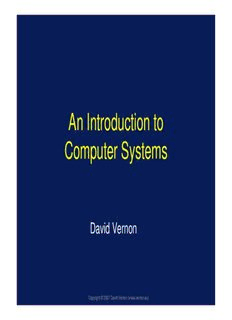
Introduction to Computer Architecture PDF
Preview Introduction to Computer Architecture
An Introduction to Computer Systems David Vernon Copyright ©2007 David Vernon (www.vernon.eu) A Computer .... takes input • processes it according to stored instructions • produces results as output • Copyright ©2007 David Vernon (www.vernon.eu) Key Concepts Input: Data • Instructions: Software, Programs • Output: Information (numbers, words, • sounds, images) Copyright ©2007 David Vernon (www.vernon.eu) Types of Computer Computer Special Purpose General Purpose (embedded systems) (user-programmable) Pre-programmed Can be adapted to many situations Watches Traffic Signals Personal Computers Workstations Engine Management Televisions Mainframes Supercomputers Telephones Navigation Devices Copyright ©2007 David Vernon (www.vernon.eu) Data vs Information A A • • – your grade in the exam 2, 4, 23, 30, 31, 36 2, 4, 23, 30, 31, 36 • • – Next week’s Lotto numbers Copyright ©2007 David Vernon (www.vernon.eu) Key Concepts Codes • – Data and information can be represented as electrical signals (e.g. Morse code) – A code is a set of symbols (such as dots and dashes in Morse code) that represents another set of symbols, » such as the letters of the alphabet, » or integers or real numbers, » or light in an image, » for the tone of a violin Copyright ©2007 David Vernon (www.vernon.eu) Key Concepts A circuit is an inter-connected set of • electronic components that perform a function Integrated Circuits (ICs) • – Combinations of thousands of circuits built on tiny pieces of silicon called chips Copyright ©2007 David Vernon (www.vernon.eu) Key Concepts Binary signal (two state signal) • – Data with two states – off & on – low voltage & high voltage – 0v & 5v Copyright ©2007 David Vernon (www.vernon.eu) Key Concepts Bit • – Single Binary Digit – Can have value 0 or 1, and nothing else – A bit is the smallest possible unit of information in a computer Copyright ©2007 David Vernon (www.vernon.eu) Key Concepts Groups of bits can represent data or • information – 1 bit - 2 alternatives – 2 bits - 4 alternatives – 3 bits - 8 alternatives – 4 bits - 16 alternatives n – n bits - 2 alternativies 8 – 8bits - 2 = 256 alternatives – a group of 8 bits is called a byte Copyright ©2007 David Vernon (www.vernon.eu)
Description: